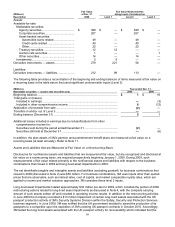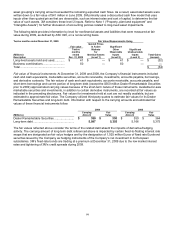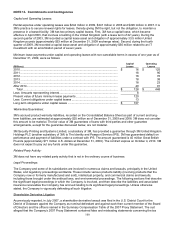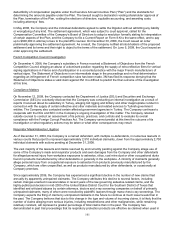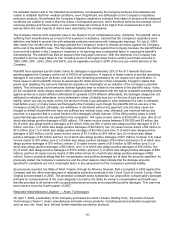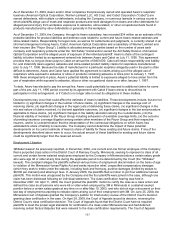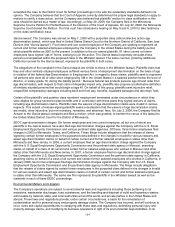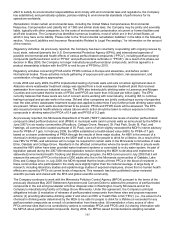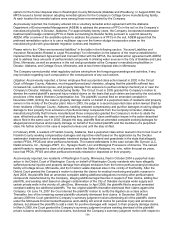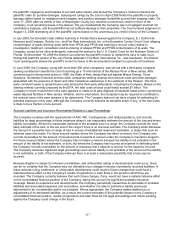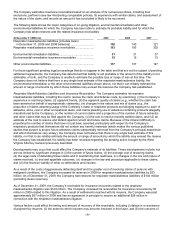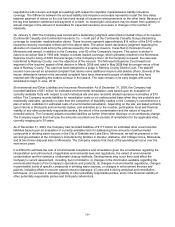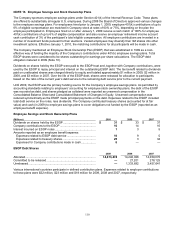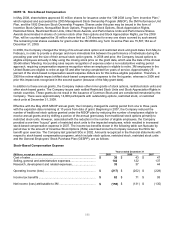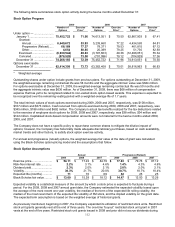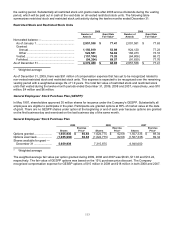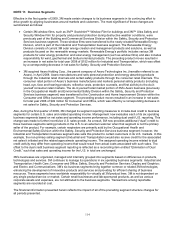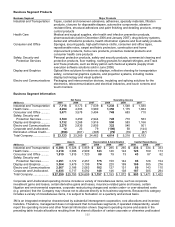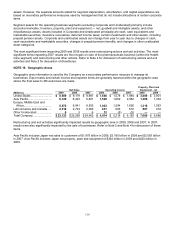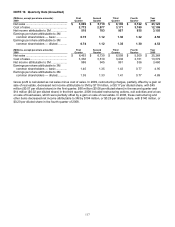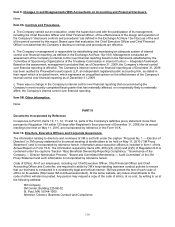3M 2009 Annual Report Download - page 114
Download and view the complete annual report
Please find page 114 of the 2009 3M annual report below. You can navigate through the pages in the report by either clicking on the pages listed below, or by using the keyword search tool below to find specific information within the annual report.
108
The Company estimates insurance receivables based on an analysis of its numerous policies, including their
exclusions, pertinent case law interpreting comparable policies, its experience with similar claims, and assessment of
the nature of the claim, and records an amount it has concluded is likely to be recovered.
The following table shows the major categories of on-going litigation, environmental remediation and other
environmental liabilities for which the Company has been able to estimate its probable liability and for which the
Company has taken reserves and the related insurance receivables:
At December 31 (Millions) 2009 2008 2007
Respirator mask/asbestos liabilities (includes Aearo
in December 31, 2009 and 2008 balances) ............................
.
138 140 121
Respirator mask/asbestos insurance receivables.......................
.
143 193 332
Environmental remediation liabilities...........................................
.
31 31 37
Environmental remediation insurance receivables .....................
.
15 15 15
Other environmental liabilities .....................................................
.
117 137 147
For those significant pending legal proceedings that do not appear in the table and that are not the subject of pending
settlement agreements, the Company has determined that liability is not probable or the amount of the liability is not
estimable, or both, and the Company is unable to estimate the possible loss or range of loss at this time. The
Company does not believe that there is any single best estimate of the respirator/mask/asbestos liability, the
environmental remediation or the other environmental liabilities shown above, nor that it can reliably estimate the
amount or range of amounts by which those liabilities may exceed the reserves the Company has established.
Respirator Mask/Asbestos Liabilities and Insurance Receivables: The Company estimates its respirator
mask/asbestos liabilities, including the cost to resolve the claim and defense costs, by examining: (i) the Company’s
experience in resolving claims, (ii) apparent trends, (iii) the apparent quality of claims (e.g., whether the claim has
been asserted on behalf of asymptomatic claimants), (iv) changes in the nature and mix of claims (e.g., the
proportion of claims asserting usage of the Company’s mask or respirator products and alleging exposure to each of
asbestos, silica, coal or other occupational dusts, and claims pleading use of asbestos-containing products allegedly
manufactured by the Company), (v) the number of current claims and a projection of the number of future asbestos
and other claims that may be filed against the Company, (vi) the cost to resolve recently settled claims, and (vii) an
estimate of the cost to resolve and defend against current and future claims. Because of the inherent difficulty in
projecting the number of claims that have not yet been asserted, particularly with respect to the Company’s
respiratory products that themselves did not contain any harmful materials (which makes the various published
studies that purport to project future asbestos claims substantially removed from the Company’s principal experience
and which themselves vary widely), the Company does not believe that there is any single best estimate of this
liability, nor that it can reliably estimate the amount or range of amounts by which the liability may exceed the reserve
the Company has established. No liability has been recorded regarding the pending action brought by the West
Virginia Attorney General previously described.
Developments may occur that could affect the Company’s estimate of its liabilities. These developments include, but
are not limited to, significant changes in (i) the number of future claims, (ii) the average cost of resolving claims,
(iii) the legal costs of defending these claims and in maintaining trial readiness, (iv) changes in the mix and nature of
claims received, (v) trial and appellate outcomes, (vi) changes in the law and procedure applicable to these claims,
and (vii) the financial viability of other co-defendants and insurers.
As a result of the costs of aggressively defending itself and the greater cost of resolving claims of persons with
malignant conditions, the Company increased its reserves in 2009 for respirator mask/asbestos liabilities by $33
million. As of December 31, 2009, the Company had reserves for respirator mask/asbestos liabilities of $104 million
(excluding Aearo reserves).
As of December 31, 2009, the Company’s receivable for insurance recoveries related to the respirator
mask/asbestos litigation was $143 million. The Company increased its receivables for insurance recoveries by $7
million in 2009 related to this litigation. As a result of settlements reached with its insurers, the Company was paid
approximately $57 million in 2009 and has an agreement in principle to receive an additional $28 million in
connection with the respirator mask/asbestos litigation.
Various factors could affect the timing and amount of recovery of this receivable, including (i) delays in or avoidance
of payment by insurers; (ii) the extent to which insurers may become insolvent in the future, and (iii) the outcome of


